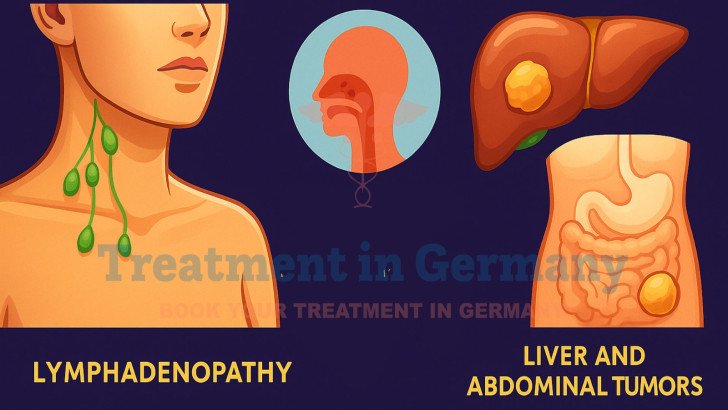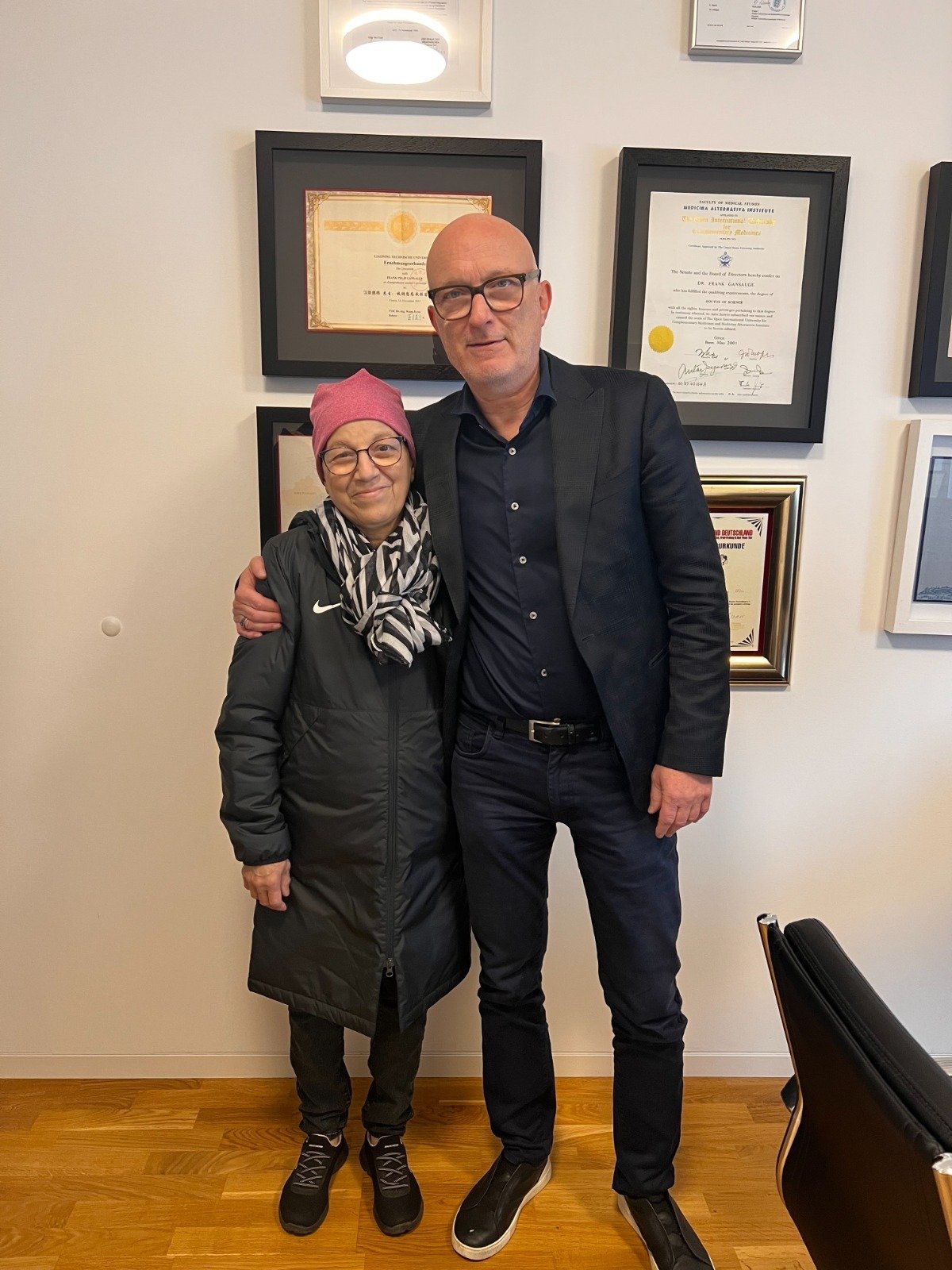
Learn how lymphadenopathy can indicate liver and abdominal tumors. Discover early signs, symptoms, and diagnostic methods to ensure timely detection and treatment.
Lymphadenopathy, which is the abnormal enlargement of lymph nodes, is a symptom that often requires medical evaluation because it can be linked to serious health conditions, including liver and abdominal tumors. Although lymphadenopathy can result from infections or inflammatory conditions, its persistent presence may indicate underlying cancer. Understanding the causes, diagnostic process, and clinical significance of lymphadenopathy is crucial for timely detection and effective management. For international patients seeking expert evaluation, German healthcare centers offer specialized diagnostic services and treatment options.
Lymphadenopathy refers to the swelling or enlargement of lymph nodes, which are small, bean-shaped structures that are part of the lymphatic system. The lymphatic system plays a vital role in immune defense, filtering harmful substances, and transporting immune cells throughout the body. Lymph nodes respond to infections, inflammation, and malignancies by increasing in size. While many causes of lymphadenopathy are benign, persistent or unusual patterns of swelling may indicate the presence of cancer.
Enlarged lymph nodes associated with cancer can occur either because the tumor has spread to these nodes or because the immune system is reacting to tumor antigens. In the context of liver and abdominal tumors, specific lymph nodes, such as celiac, para-aortic, and mesenteric nodes, are clinically significant. Enlargement of these nodes often occurs before other symptoms of the tumor become noticeable, making lymphadenopathy an important early warning sign.
Healthcare professionals look for several features when evaluating lymphadenopathy:
Size: Nodes larger than one centimeter are generally considered abnormal, especially if the enlargement persists.
Consistency: Hard or firm nodes are more concerning than soft or rubbery ones.
Mobility: Fixed or immobile nodes suggest invasive disease.
Number and distribution: Multiple nodes in deep abdominal regions, especially if asymmetric, require further investigation.
Associated symptoms: Unexplained weight loss, persistent fatigue, night sweats, fever, or jaundice may indicate malignancy.
Early evaluation is essential, as timely detection can significantly improve treatment outcomes. German specialists utilize precise diagnostic protocols to differentiate between benign and malignant lymphadenopathy, offering international patients detailed assessment and care coordination.
How Liver Tumors Contribute to Lymph Node Enlargement
Liver tumors can be primary, such as hepatocellular carcinoma, or secondary, resulting from metastasis from other organs. Tumor cells can spread to regional lymph nodes through the lymphatic system, leading to lymphadenopathy. Enlargement of nodes in the hepatic and celiac regions is a common sign of liver tumor progression.
Symptoms associated with liver tumors include abdominal discomfort or pain, swelling in the upper abdomen, unexplained weight loss, fatigue, and jaundice. Since these symptoms are often subtle in early stages, lymphadenopathy can serve as a crucial indicator for further evaluation. German healthcare centers employ advanced imaging modalities, including CT scans, MRI, and PET scans, to detect lymph node involvement and determine the extent of disease.
The Link between Abdominal Tumors and Lymphadenopathy
Abdominal tumors, which can develop in organs such as the stomach, pancreas, kidneys, intestines, and lymphatic tissues themselves, frequently metastasize to regional lymph nodes early in disease progression. Lymphadenopathy in these areas may not produce noticeable symptoms, which is why imaging and thorough clinical evaluation are essential.
The involvement of lymph nodes helps doctors stage the tumor, assess prognosis, and guide treatment decisions. Minimally invasive biopsy techniques are often used to confirm malignancy and understand the nature of cancer cells. German specialists have significant experience in these procedures, providing precise diagnostic information to guide treatment strategies.
Diagnostic Approaches for Lymphadenopathy Related to Liver and Abdominal Tumors
Accurate diagnosis is the cornerstone of effective cancer management. The following methods are widely used to evaluate lymphadenopathy:
Ultrasound: Often the first imaging technique used to detect abnormal lymph nodes and guide biopsies.
CT scans: Provide detailed cross-sectional images of the liver, abdominal organs, and lymph nodes, helping to identify size, location, and structure.
MRI scans: Offer high-resolution images for soft tissue evaluation, particularly useful for liver tumors.
PET scans: Detect metabolically active cancer cells and provide information on tumor spread.
Biopsies: Fine needle aspiration or core biopsy allows for histopathological analysis to confirm the presence of cancer.
Laboratory tests: Blood tests, liver function tests, and tumor markers can provide additional information about underlying malignancies.
Combining these diagnostic tools allows doctors to accurately stage the disease, evaluate prognosis, and formulate an appropriate treatment plan.
Treatment Approaches for Lymphadenopathy in Cancer Patients
The treatment of lymphadenopathy associated with liver and abdominal tumors depends on the underlying tumor type, stage, and the patient’s overall health. Common approaches include:
Surgical intervention: Removal of the primary tumor and affected lymph nodes.
Radiation therapy: Targeted treatment to eliminate cancer cells in specific regions.
Chemotherapy: Systemic treatment for cancer that has spread to multiple areas.
Targeted therapy and immunotherapy: Used based on molecular characteristics of the tumor.
Personalized treatment plans are essential to maximize outcomes and minimize complications. German specialists tailor each treatment plan to the patient’s condition, ensuring careful monitoring throughout the process. For international patients, TIG (Treatment in Germany) www.treatmentingermany.de provides seamless coordination and complete logistic arrangements for patients, including travel, lodging, and medical visa for international patients (if required).
Importance of Early Detection and Continuous Monitoring
Detecting lymphadenopathy early can significantly affect treatment outcomes. Routine imaging for high-risk patients, monitoring of symptoms, and timely biopsies are critical steps in cancer management. After treatment, regular follow-up and imaging are necessary to detect any recurrence or spread. German healthcare centers emphasize comprehensive follow-up care to ensure long-term monitoring and management.
🌍Why Patients Worldwide Prefer Our Medical Services in Germany – Key Benefits Explained:
Frequently Asked Questions (FAQs)
1. What does swollen lymph nodes near the liver indicate?
Swollen lymph nodes near the liver may suggest liver-related inflammation or liver tumors and require medical evaluation.
2. Can lymphadenopathy be an early sign of abdominal cancer?
Yes, persistent or firm lymph node enlargement in the abdominal area can indicate abdominal tumors.
3. How is lymphadenopathy diagnosed in liver and abdominal cancers?
Diagnosis typically involves ultrasound, CT scans, MRI, PET scans, and biopsies.
4. Are enlarged lymph nodes always cancerous?
No, lymphadenopathy can be caused by infections or autoimmune conditions, but persistent enlargement may need cancer evaluation.
5. What are common symptoms associated with cancer-related lymphadenopathy?
Symptoms include weight loss, fatigue, night sweats, jaundice, and abdominal discomfort.
6. How do liver tumors spread to lymph nodes?
Cancer cells can travel through the lymphatic system, causing enlargement in nearby nodes.
7. Can international patients receive treatment for lymphadenopathy-related cancers in Germany?
Yes, German healthcare centers offer diagnostics and treatment for international patients, with complete coordination for all logistical arrangements and medical visas (if required) through TIG (Treatment in Germany).
8. Why is early detection of lymphadenopathy important?
Early detection allows for timely diagnosis and treatment, improving outcomes for liver and abdominal tumors.
Kindly complete the form below, and our dedicated team will reach out to you promptly. We look forward to connecting with you soon!
Trierer Straße, 56072 Koblenz, Germany
.webp)
.webp)
 (1).webp)
 (1).webp)

.webp)
.webp)
 (1).webp)
 (1).webp)
